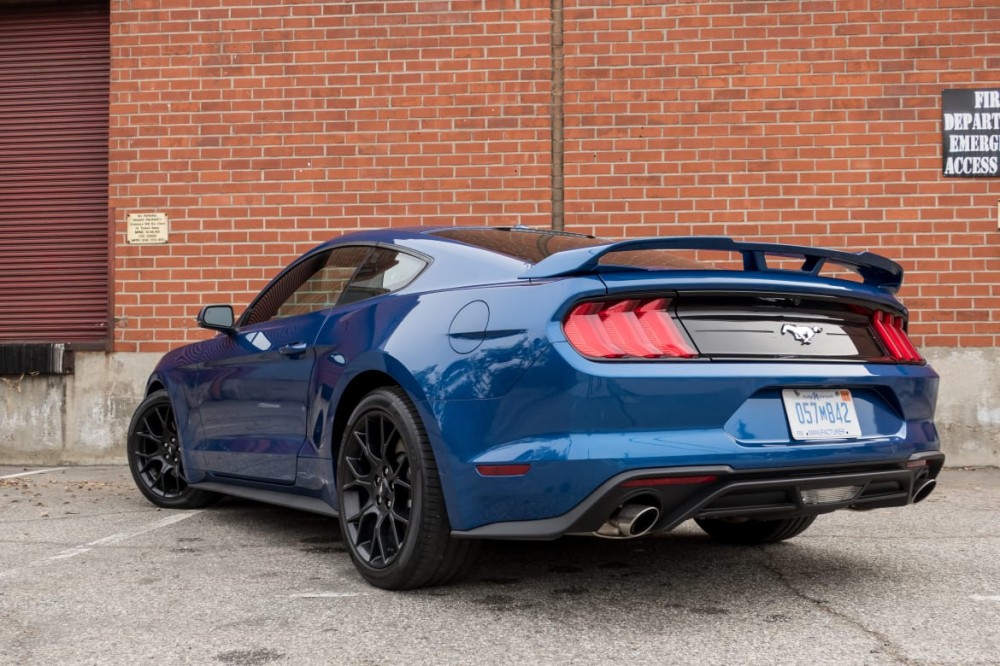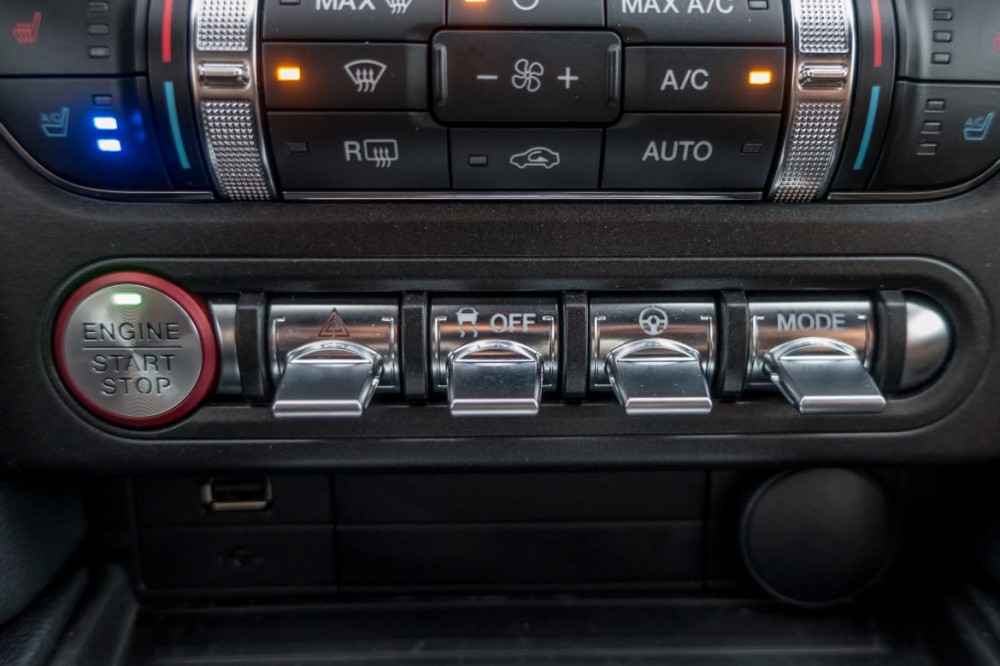The verdict: The Mustang’s evolution from muscle car to impressive all-around sports car continues.
Versus the competition: The Mustang’s styling and performance occupy a middle ground between the ultra-retro Challenger and the modern Camaro, but its excellent technology beats both handily.
The Ford Mustang is the original muscle car, a slice of history and a symbol of one of the world's largest automakers, all bundled into one American icon. With its 2016 redesign, the Mustang shed a few other labels — for the better. It can still shred tires with the best of them, but chassis upgrades and the elimination of a live rear axle marked the Mustang's turn from one-trick pony to legitimate sports car, with handling and agility to match.
In the narrow world of muscle cars, the Mustang has only two true competitors: the Chevrolet Camaro and the Dodge Challenger (compare all three here). Regardless, the class is rife with changes as those three companies try to outdo each other. In the past year alone, we've seen the introduction of an ultimate edition of the Camaro (the ZL1) and a new, high-powered Challenger (the SRT Demon) that can do unspeakable things at drag strips.



Unlike those cars, the 2018 Mustang's updates cover all trim levels, continuing its evolution into a well-rounded sports car. For a refresh, the changes are extensive, including both powertrains, the suspension and the exterior styling, as well as updates to the technology, safety and exhaust systems. Ford's MagneRide adaptive suspension, previously available only on the Shelby GT350 and GT350R, is now offered up and down the lineup. Compare the 2018 Mustang with last year's model here.
The Mustang comes with a choice of two engines and in a pair of body styles: four-cylinder or V-8 (there's no more base V-6) and coupe or convertible. I tested what Ford says will be the most popular option: a coupe with the turbocharged 2.3-liter EcoBoost four-cylinder and a 10-speed automatic transmission that's new for 2018. Here are the details, as tested:
2018 Ford Mustang EcoBoost Premium Fastback
Powertrain: 310-horsepower, turbocharged 2.3-liter four-cylinder, 350 pounds-feet of torque; 10-speed automatic transmission; rear-wheel drive
Rated fuel economy: 21/32/25 mpg city/highway/combined
Key features: EcoBoost Performance Package (3.55 limited-slip rear axle, 19-inch black wheels, larger brakes and radiator, rear wing), MagneRide adaptive suspension, Sync 3 multimedia system, 12.4-inch digital instrument cluster, heated/ventilated seats, electronic line-lock, Wi-Fi hot spot, Android Auto and Apple CarPlay, Safe & Smart Package (autonomous emergency braking, lane keep assist, blind spot monitors, adaptive cruise control, automatic high beams and rain-sensing wipers)
Price: $41,375 (including destination charges)
Mechanical Updates
Both Mustang engines see power boosts for 2018. The EcoBoost engine makes the same horsepower (310) but much more torque — 350 pounds-feet, up from 320. There are more updates on the 5.0-liter V-8, including a new crankshaft, fuel delivery system and new cylinder heads. These bump power more significantly, to 460 hp (from 435) and 420 pounds-feet of torque (from 400).
The new, optional 10-speed automatic transmission is the result of a joint venture between Ford and GM (of all things); it first appeared on the Ford F-150 Raptor and Chevrolet Camaro ZL1. The standard six-speed manual gets some upgrades in V-8 models, adding a dual-mass flywheel and a twin-disc clutch to help handle the extra torque.
It's a bit weird to drive a four-cylinder Mustang, even if it is a turbocharged engine that makes more power than the previous V-6. The added torque is a nice bonus, making the 2018 feel quicker than last year's car. That could also be due to the 10-speed automatic, which is just as fantastic here as it is in the Raptor. The transmission doesn't get tripped up when you mash on the gas; it grabs gears quickly and seamlessly flips through all the speeds as you accelerate. Even in the new Drag Strip mode, it didn't falter. I punched the accelerator hard in a straight line, and the transmission got the engine up to the top of the range and ripped through shifts in rapid succession (much faster than I'd have any hope of doing with a manual), all while keeping the Mustang hurtling forward at greater and greater speeds.
Wait, How Many Drive Modes?
Speaking of drive modes, the 2018 Mustang isn't short of settings to change how the car handles and performs. Besides the aforementioned Drag Strip mode, there's Normal, Sport Plus, Track and Snow/Wet. Beyond that, there's a toggle that switches the power steering assist between Normal and Sport. Then there are three traction control settings: on, partial off and all the way off. On top of that, there's the line-lock (a.k.a. burnout) mode, which for 2018 is standard on EcoBoost models, too, not just the GT.
There's good differentiation between the drive modes and, unlike most vehicles — which I usually leave in Sport — I found myself using different driving modes for different occasions: Normal on the street, Sport Plus and Track in canyons, and Drag Strip when safety (and space) allowed. And, of course, line lock, because who doesn't love a good burnout? The only mode I didn't really test was Snow/Wet because I live in Los Angeles, where those things are more rumors than actual driving conditions.



I was initially a bit disappointed on curvier roads in Sport Plus. The mode isn't quite aggressive enough with throttle mapping, and the optional MagneRide suspension wasn't firm enough to make the Mustang feel sharp. This is a four-cylinder engine, after all, and the Mustang isn't a light vehicle. That means that if the mode isn't aggressive enough, the nose will feel heavy, turn-in will be sluggish and the engine will lag. Once I flipped into Track, though, I had my "aha" moment and was enamored with the car again. In that mode, the Mustang feels like it sheds a bunch of weight and turns into a flickable car that eats up corners with aplomb. It also does a better job keeping the engine in the power band, where those 310 horses are more readily available.
The MagneRide suspension doesn't come cheap. To get it, you first have to add the EcoBoost Performance Package for $2,495 (or the $3,995 GT Performance Package on GT models), then drop another $1,695 for the suspension. Ford will also offer a Performance Pack Level 2 for manual GTs that will include the suspension, but it will add $6,500 to the bottom line. I loved what the suspension did to the EcoBoost, but it's an expensive proposition.
If the mode isn't aggressive enough, the nose feels heavy, turn-in is sluggish and the engine lags, but once I flipped into Track mode, I had my “aha” moment and was enamored with the car again.
Many Screens, Many Screens
Beyond the performance upgrades, what really impressed me about the Mustang was its technology. Each aspect was easy to use and navigate — no small feat given the amount of multimedia, performance and safety technology present.
Sync 3 remains one of our favorite multimedia systems, but the real star here is the new 12.4-inch digital instrument cluster, which replaces the traditional gauges with a fully digital display. Ford says it spent more than 2,000 hours developing graphics and configuring menus and screens to find the best way to present information, and that effort shows. The screens are easy to navigate and control using buttons on the steering wheel.



When the drive mode is changed, the appearance of the cluster changes, as well. In Normal mode, things are pretty standard, but bump into Sport Plus and the tachometer unfurls to take up much of the top of the screen. In Track and Drag modes, the screen gets simplified even further with a large, easy-to-read tachometer that changes colors to indicate shift points (green to yellow to red) and a digital readout for your speed. If you activate line-lock mode, an animation of a spinning tire appears, spewing its own smoke as you step on the gas. The system also offers 900 color combinations for the gauges and ambient lighting around the cabin.
I came away impressed by the system's speed and appearance. Is it a little gimmicky? Maybe, but I had too much fun with it to care.
Safety Features
In addition to its performance and technology features, the Mustang offers a comprehensive suite of safety technology. My test vehicle included the Safe & Smart Package, a $1,495 option that adds forward automatic emergency braking with pedestrian detection, adaptive cruise control, automatic high beams, blind spot warning and a lane-keeping system, among other features. This is one option box I'd definitely check in part because, while visibility out the Mustang is better than the Camaro, it's still not great.
Here Comes the But
The EcoBoost-equipped Mustang with all these new bells and whistles is very, very good. It's also pretty damn expensive, as my $41,375 test vehicle proves. The technology and performance upgrades that had me so enamored add up quickly, yet they're so good and so enrich the driving experience that it would be hard for me to buy a Mustang without them. The Mustang can now pass for a muscle car, a grand tourer or a sports car. It just costs a lot to get there.


My other slight hang-up with the EcoBoost engine is the existence of the GT. Did I miss the V-8? At times, yes. When I picked up my test car, a GT was parked right in front of it. As I was busy admiring/Instagramming my car, another journalist hopped into the GT, fired it up and drove off, leaving me, that engine note and some regret behind. The EcoBoost pipes in engine noise through the audio system, yet even with that artificial boost, it's underwhelming. The GT (especially with the new active exhaust system) gives you an intoxicating growl.
Overall, though, the 2018 Mustang moves the Mustang's evolution forward, and those small steps in many areas add up to a giant leap for the whole vehicle. It's so, so good.
Cars.com's Editorial department is your source for automotive news and reviews. In line with Cars.com's long-standing ethics policy, editors and reviewers don't accept gifts or free trips from automakers. The Editorial department is independent of Cars.com's advertising, sales and sponsored content departments.








